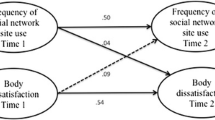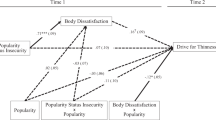Abstract
The primary aim of this study was to test a multivariate model of predictors of body dissatisfaction in adolescent girls in which psychological variables, beliefs about the importance of popularity with boys, and beliefs about the importance of thinness to attractiveness and dating were included. We also aimed to explore boys' perceptions of the importance of thinness for attractiveness. Grade 10 girls (n = 573) and boys (n = 145) completed questionnaires. Path analysis provided partial support for the model proposed. Dating did not predict body dissatisfaction, but a relationship between importance of popularity with boys and body dissatisfaction was fully mediated by the belief that boys see thinness as important in rating girls' attractiveness. Although girls underestimated the body size that is attractive to boys, over 85% of boys reported a girl's slimness influenced her attractiveness. Dating was not correlated with body mass index.
Similar content being viewed by others
References
Banasiak, S. J., Wertheim, E. H., Koerner, J., & Voudorouris, N. J. (2001). Test-retest reliability and internal consistency of a variety of measures of dietary restraint and body concerns in a sample of adolescent girls. International Journal of Eating Disorders, 29, 85–89.
Beck, A. T., & Beck, R. W. (1972). Screening depressed patients in family practice: A rapid technique. Postgraduate Medicine, 52, 81–85.
Beck, A. T., Rial, W. Y., & Rickels, K. (1974). Short form of the Depression Inventory: Cross validation. Psychological Reports, 34, 1184–1186.
Ben-Tovim, D. I., & Walker, K. (1991). The influence of age and weight on women's body attitudes as measured by the Body Attitudes Questionnaire (BAQ). Journal of Psychosomatic Research, 38, 477–481.
Bersheid, E., Dion, K., Walster, E., & Walster, G. W. (1971). Physical attractiveness and dating choice: A test of the matching hypothesis. Journal of Experimental Social Psychology, 7, 173–189.
Byrnes, S. E., Burns, C., & Baur, L. A. (1995, October). A validation study of the Ben-Tovim-Walker Body Attitudes Questionnaire in girls 12–16 years. Paper presented at the Australian Society for the Study of Obesity Conference, Melbourne, Australia.
Cauffman, E., & Steinberg, L. (1996). Interactive effects of menarcheal status and dating on dieting and disordered eating among adolescent girls. Developmental Psychology, 32, 631–635.
Cawley, J. (2001). Body weight and the dating and sexual behaviors of young adolescents. In R. T. Michael (Ed.), Social awakening: Adolescent behavior as adulthood approaches (pp. 174–198). New York: Russell Sage Foundation.
Cohn, L. D., & Adler, N. E. (1992). Female and male perceptions of ideal body shapes: Distorted views among Caucasian college students. Psychology of Women Quarterly, 16, 69–79.
Cohn, L. D., Adler, N. E., Irwin, C. E., Jr., Millstein, S. G., Kegeles, S. M., & Stone, G. (1987). Body-figure preferences in male and female adolescents. Journal of Abnormal Psychology, 96, 276–279.
Damhorst, M., Littrell, J., & Littrell, M. (1988). Age differences in adolescent body satisfaction. Journal of Psychology, 121, 553–562.
Durkin, S. J., & Paxton, S. J. (2002). Predictors of vulnerability to reduced body image satisfaction and psychological well-being in response to exposure to idealized female media images in adolescent girls. Journal of Psychosomatic Research, 53, 995–1005.
Fallon, A. E., & Rozin, P. (1985). Sex differences in perceptions of desirable body shape. Journal of Abnormal Psychology, 94, 102–105.
Forbes, G. B., Adams-Curtis, L. E., Rade, B., & Jaberg, P. (2001). Body dissatisfaction in women and men: The role of gender-typing and self-esteem. Sex Roles, 44, 461–484.
Garner, D. M., Olmsted, M. P., & Polivy, J. (1983). Development and validation of a multidimensional Eating Disorder Inventory for anorexia nervosa and bulimia. International Journal of Eating Disorders, 2, 15–34.
Gralen, S. J., Levine, M. P., Smolak, L., & Murnen, S. K. (1990). Dieting and disordered eating during early and middle adolescence: Do the influences remain the same? International Journal of Eating Disorders, 9, 501–512.
Groesz, L. M., Levine, M. P., & Murnen, S. K. (2002). The experimental presentation of thin media images on body dissatisfaction: A meta-analytic review. International Journal of Eating Disorders, 31, 1–16.
Halpern, C., Udry, R., Campbell, B., & Suchindran, C. (1999). Effects of body fat on weight concerns, dating, and sexual activity: A longitudinal analysis of Black and White adolescent girls. Developmental Psychology, 35, 721–736.
Keery, H., van den Berg, P., & Thompson, J. K. (2004). An evaluation of the tripartite influence model of body dissatisfaction and eating disturbance with adolescent girls. Body Image, 1, 237–251.
Keys, A., Fidanza, F., Karvonen, M. J., Kimura, N., & Taylor, H. L. (1972). Indices of relative weight and obesity. Journal of Chronic Diseases, 25, 329.
Laessle, R. G., Tuschl, R. J., Kotthaus, B. C., & Pirke, K. M. (1989). A comparison of the validity of three scales for the assessment of dietary restraint. Journal of Abnormal Psychology, 98, 504–507.
Levine, M., & Harrison, K. (2004). Media's role in the perpetuation and prevention of negative body image and disordered eating. In J. K. Thompson (Ed.), Handbook of eating disorders and obesity (pp. 695–717). New York: John Wiley & Sons, Inc.
Levine, M. P., Smolak, L., Moodey, A. F., Shuman, M. D., & Hessen, L. D. (1994). Normative developmental challenges and dieting and eating disturbances in middle school girls. International Journal of Eating Disorders, 15, 11–20.
Lieberman, M., Gauvin, L., Bukowski, W., & White, D. (2001). Interpersonal influence and disordered eating behaviors in adolescent girls: The role of peer modeling, social reinforcement, and body-related teasing. Eating Behaviors, 2, 215–236.
Mutterperl, J. A., & Sanderson, C. A. (2002). Mind over matter: Internalization of the thinness norm as a moderator of responsiveness to norm misperception education in college women. Health Psychology, 21, 519–523.
Nichter, M., & Vuckovic, N. (1994). Fat talk: Body image among adolescent females. In N. Sault (Ed.), Many mirrors: Body image and social relations (pp. 109–131). New Brunswick, NJ: Rutgers University Press.
Paxton, S. J., Schutz, H. K., Wertheim, E. H., & Muir, S. (1999). Friendship clique and peer influences on body image concerns, dietary restraint, extreme weight-loss behaviors, and binge eating in adolescent girls. Journal of Abnormal Psychology, 108, 255–266.
Rosenberg, M. (1965). Measurement of self-esteem. In M. Rosenberg (Ed.), Society and the adolescent self image (pp. 297–307). Princeton, NJ: Princeton University Press.
Sanderson, C. A., Darley, J. M., & Messinger, C. S. (2002). “I'm not as thin as you think I am”: The development and consequences of feeling discrepant from the thinness norm. Personality and Social Psychology Bulletin, 28, 172–183.
Schutz, H. K., Paxton, S. J., & Wertheim, E. H. (2002). Investigation of body comparison among adolescent girls. Journal of Applied Psychology, 32, 1906–1937.
Shoemaker, C., Van Strien, T., & Van Der Staak, C. (1994). Validation of the Eating Disorder Inventory in a non clinical population using transformed and untransformed responses. International Journal of Eating Disorders, 15, 387–393.
Shore, R. A., & Porter, J. E. (1990). Normative and reliability data for 11 to 18 year olds on the Eating Disorder Inventory. International Journal of Eating Disorders, 9, 201–207.
Simmons, R. G., & Blyth, D. A. (1987). Moving into adolescence: The impact of pubertal change and school context. Hawthorne, NY: Aldine Press.
Smolak, L., Levine, M. P., & Gralen, S. (1993). The impact of puberty and dating on eating problems among middle school girls . Journal of Youth and Adolescence, 22, 355–368.
Stake, J., & Lauer, M. (1987). The consequences of being overweight: A controlled study of gender differences. Sex Roles, 17, 31–47.
Stice, E. (2001). A prospective test of the dual-pathway model of bulimic pathology: Mediating effects of dieting and negative affect. Journal of Abnormal Psychology, 110, 124–135.
Stice, E. (2002). Risk and maintenance factors for eating pathology: A meta-analytic review. Psychological Bulletin, 128, 825–848.
Stice, E., Presnell, K., & Spangler, D. (2002). Risk factors for binge eating onset in adolescent girls: A 2-year prospective investigation. Health Psychology, 21, 131–138.
Teri, L. (1982). The use of the Beck Depression Inventory with adolescents. Journal of Abnormal Child Psychology, 10, 277–284.
Thompson, J. K., Heinberg, L. J., Altabe, M., & Tantleff-Dunn, S. (1999). Exacting beauty: Theory, assessment, and treatment of body image disturbance. Washington, DC: American Psychological Association.
Thompson, J. K., & Stice, E. (2001). Thin-ideal internalization: Mounting evidence for a new risk factor for body-image disturbance and eating pathology. Current Directions in Psychological Science, 10, 181–183.
Van Strien, T., Frijters, J. E. R., Bergers, G. P. A., & Defares, P. B. (1986). The Dutch Eating Behavior Questionnaire (DEBQ) for assessment of restrained, emotional, and external eating behavior. International Journal of Eating Disorders, 5, 295–315.
Wertheim, E. H., Koerner, J., & Paxton, S. J. (2001). Longitudinal predictors of restrictive eating and bulimic tendencies in three different age groups of adolescent girls. Journal of Youth and Adolescence, 30, 69–81.
Wertheim, E. H., Paxton, S. J., & Blaney, S. (2004). Risk factors for body image dissatisfaction. In J. K. Thompson (Ed.), Handbook of eating disorders and obesity (pp. 463–494). New York: Wiley.
Wertheim, E. H., Paxton, S. J., Maude, D., Szmukler, G. I., Gibbons, K., & Hillier, L. (1992). Psychosocial predictors of extreme weight loss behaviors and binge eating in adolescent girls and boys. International Journal of Eating Disorders, 12, 151–160.
Wertheim, E. H., Paxton, S. J., Schutz, H. K., & Muir, S. (1997). Why do adolescent girls watch their weight? An interview study examining sociocultural pressures to be thin. Journal of Psychosomatic Research, 42, 345–355.
Author information
Authors and Affiliations
Corresponding author
Rights and permissions
About this article
Cite this article
Paxton, S.J., Norris, M., Wertheim, E.H. et al. Body Dissatisfaction, Dating, and Importance of Thinness to Attractiveness in Adolescent Girls. Sex Roles 53, 663–675 (2005). https://doi.org/10.1007/s11199-005-7732-5
Issue Date:
DOI: https://doi.org/10.1007/s11199-005-7732-5




